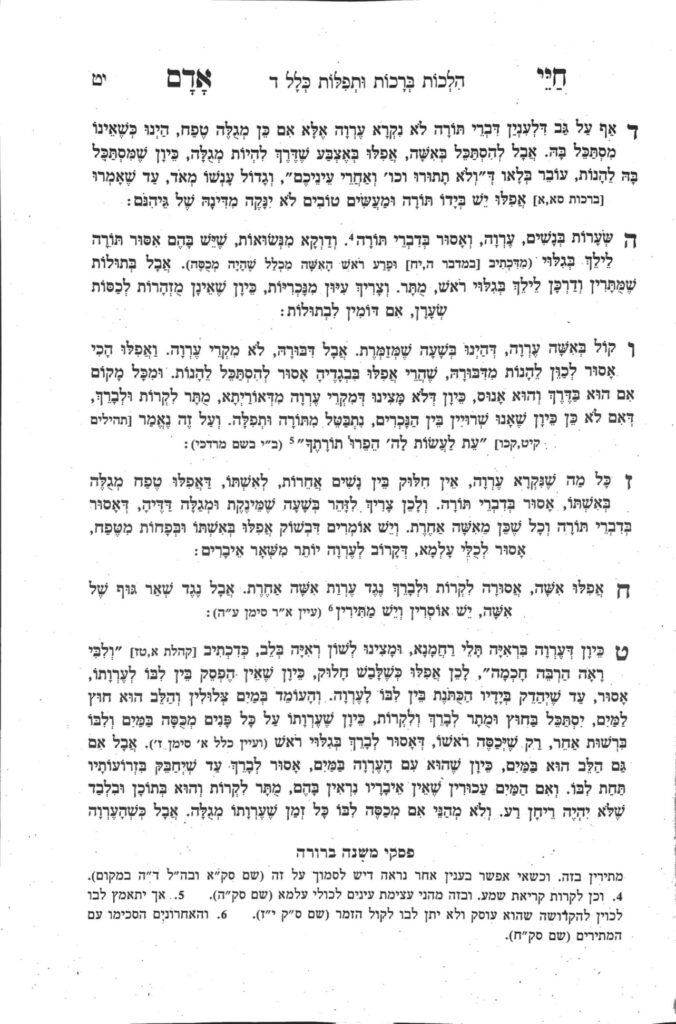We are continuing in siman 5, discussing hair. The Rema in Orach Chaim (siman 72) quotes the Rashba, who writes that even though there is an issur to recite shema (i.e., devarim shebikedusha) in the presence of the uncovered hair of a married woman, however, that just like the hair of someone who is not married is not included in this issur, so too, a married woman’s hair which tends to go out of the tzimtan is not included in the issur either. The Mishnah Berurah explains that women used to wear a type of hat which did not cover all of their hair, so they would place another garment on their head, known as a tzimtan, to cover everything. However, even with the second garment, there could still be stubborn hairs which would not stay covered. The Rashba holds that those hairs do not fall into the issur of reciting devarim shebikedusha in the presence of uncovered hair.
The Biur Halacha is clear that the opinion of the Rashba is a machlokes, and that there are different minhagim. He discusses the halacha of a person who goes from a place where it is muttar to a place where it is assur, and vice versa, and whether a man can recite devarim shebikedusha in the presence of that uncovered hair. Either way, there does not appear to be a significant amount of hair in question.
We will next discuss hair which grows on the back of the neck, forehead, and place where men’s peyos come down (not hair which grows from the head and drops down, but hair which grows on the actual side of the face). Meikar hadin, those hairs are not considered as part of the head, and there should be no chiyuv to cover them. One understanding of the hairs coming out past the tzimtan includes these hairs. This would then depend on the minhagim in regards to the tzimtan hairs.
However, The Mishnah Berurah quotes the Zohar, which is very machmir regarding covering all hair. In the Biur Halacha, he also quotes the Chasam Sofer, who writes that the minhag in Klal Yisroel is to be machmir like the Zohar. The Magen Avraham mentions that the Minhag is in accordance with the Zohar as well.
The Chasam Sofer quotes a fascinating point from the Magen Avraham. People are familiar with the phrase that minhag oker halacha, minhag overrides halacha. The obvious difficulty is how can minhag allow someone to ignore halacha. The Magen Avraham in siman 690 explains that if a halacha is found both in the Gemara and in a secondary sefer of Chazal, such as the Masechtos Ketanos, Midrash, Zohar, etc, when the Gemara says one way and the secondary seforim say the other way, that is where the Yerushalmi applies the concept of minhag oker halacha. As both sources are from Chazal, If the minhag has become to accept one of the secondary sources of Chazal over the Gemara, that minhag will become primary and override the Gemara. Thus, although the general rule is to follow the Gemara, it is valid to follow one of the other seforim, as it is considered an understanding of how Chazal wanted us to act. The Chasam Sofer writes that this concept applies to this Zohar, in that since women throughout the ages were makpid to follow the Zohar, it now becomes the halachic standard.
Summary
-
Hair which comes out past the tzimtan (stray hairs which come out of a proper haircovering), and hair which grows on the back of the neck, forehead, and sides of the head does not need to be covered, meikar hadin. However, the minhag of Klal Yisroel has become to accept the opinion of the Zohar as the halachic standard, and to cover all hair.



